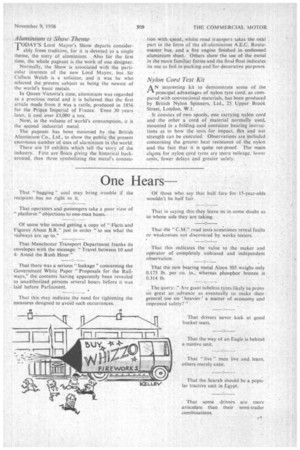Passing Comments
Page 44

Page 45

If you've noticed an error in this article please click here to report it so we can fix it.
Fuel Cleanliness Vital
rINE of the most important factors in the successful operation of oil engines is cleanliness of the fuel. Pumps and injectors would give longer and cheaper service if the fuel could be kept free from the fine abrasive dust often carried in the air and picked up from containers, fillers and such like. Much educational work towards this ideal has been carried out and a valuable contribution was the C.A.V. film "Keep It Clean."
Great strides have, however, been made since in filtration technique, including the C.A.V. paper
element filter. Accordingly, a new edition of the film, in colour, has been made. At the first showing, on October 18, Mr. H. G. Mason, director and joint general manager of C.A.V., Ltd., presented the first 16 mm. copy to Mr. W. N. Collins, director of sates and service of F. Perkins, Ltd. He also thanked that company for their help in its production. Two others who assisted were Mr. T. R. St. John Browne, Perkins' service manager, and Mr. G. Hinch, service superintendent.
The film will be used by C.A.V. depots and service agents all over the world. It was made by The Merlin Film 'Co., Ltd.
c6
Automation in Russia
THE U.S.S.R. are greatly interested in the possibilities of furthering automation in the engineering industry and they are doing a great deal to encourage it.
A number of the ministries concerned with industry recently held conferences to discuss the progress made and to outline further measures to be taken.
It was pointed out at one of these that 110,000 machine tools out of a total of 1,750,000 available were automatically or semi-automatically operated and 40 per cent. produced recently were automatons.
At the end of 1960, come 30 per cent, of the forge and press equipment produced would be either automatic or supplied with automatic feeders, but as regards automatic metal-working machines, they were behind.
In the Russian motor industry, the ministry concerned had prepared a plan for the all-round mechanization and automation of the main production processes. transport and storing operations for the period 195660. By the end of this, 50 per cent. of the basic operations in the motor factories should be mechanized or semi-automatic, as compared with 22.5 per cent. at the end of 1955.
Aluminium is Show Theme
TODAY'S Lord Mayor's Show departs considerably from tradition, for it is devoted to a single theme, the story of aluminium. Also for the first time, the whole pageant is the work of one designer. Normally, the Show is associated with the particular interests of the new Lord Mayor, but Sir Cullum Welch is a solicitor, and it was he who selected the present subject as being the newest of the world's basic metals.
In Queen Victoria's time, aluminium was regarded as a precious metal and it is believed that the first article made from it was a rattle, produced in 1856 for the Prince Imperial of France. Even 30 .years later, it cost over £3,000 a ton.
Now, in the volume of world's consumption, it is the second industrial metal.
The pageant has been mounted by the British Aluminium Co., Ltd., to show the public the present enormous number of uses of aluminium in the world.
There are 19 exhibits which tell the story of the industry. First are floats giving the historical background, then three symbolizing the metal's connec
tion with speed, whilst road transport takes the next part in the form of the all-aluminium A.E.C. Routemaster bus, and a fire engine finished in embossed aluminium sheet. Others show the use of the metal in the more familiar forms and the final float indicates its use as foil in packing and for decorative purposes.
Nylon Cord Test Kit
A N interesting kit to demonstrate some of the 1-1 principal advantages of nylon tyre cord, as compared with conventional materials, has been produced by British Nylon Spinners. Ltd., 25 Upper Brook Street, London, W.I.
It consists of two spools, one carrying nylon cord and the other a cord of material normally used, mounted in a folding card container bearing instructions as to how the tests for impact, flex and wet strength can be executed. Observations are included concerning the greater heat resistance of the nylon and, the fact that it is quite rot-proof. The main clms for nylon cord tyres are more mileage, lower costs, fewer delays and greater safety.




























































































































